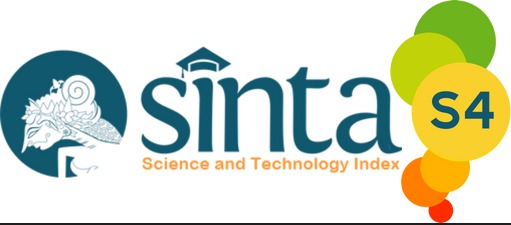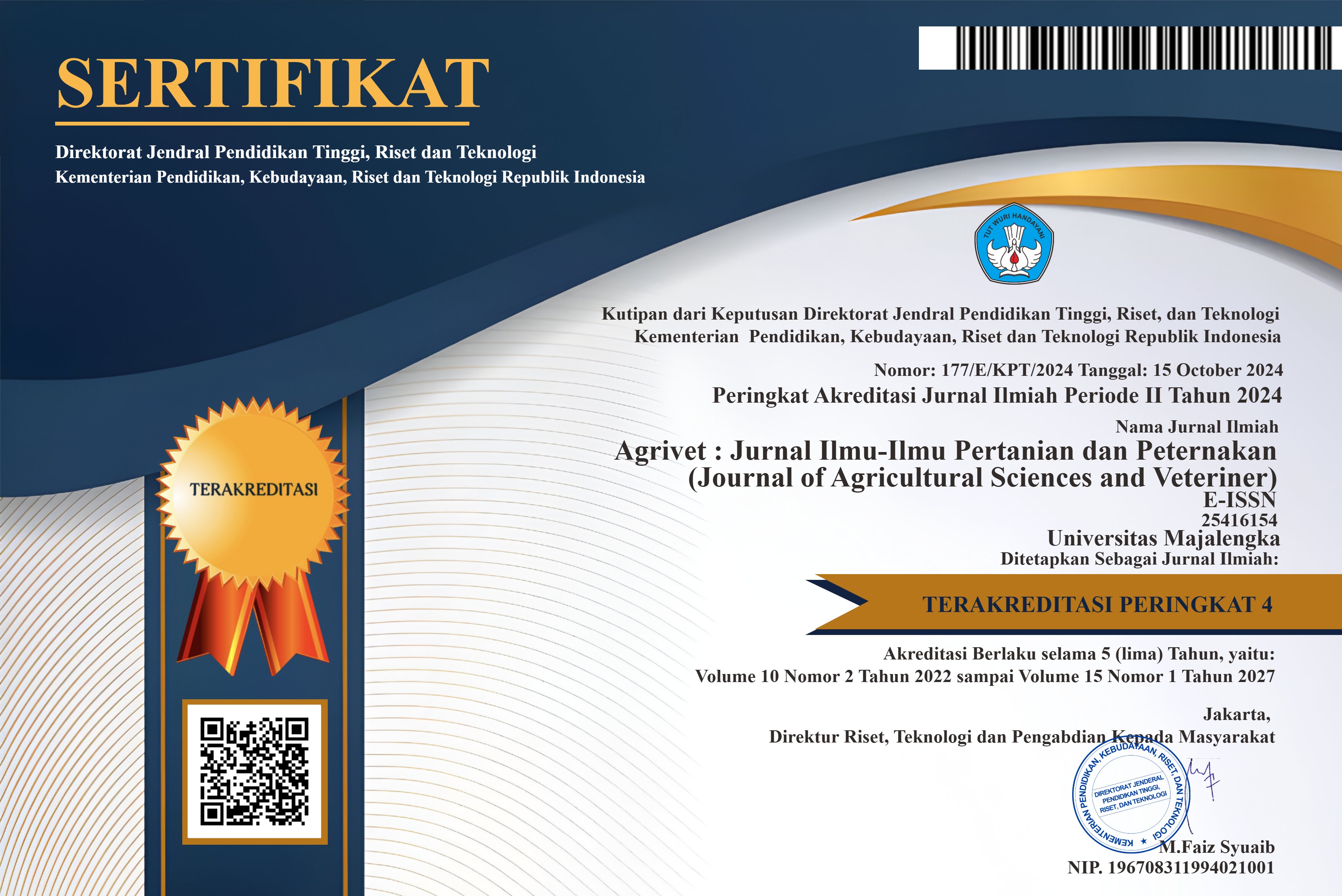Pertumbuhan dan produksi tanaman sawi hijau (Brassica juncea L.) dan bawang daun (Allium fistulosum L.) pada pola tanam tumpang sari di tanah ultisol yang diberi pupuk organik cair urin kelinci
DOI:
https://doi.org/10.31949/agrivet.v13i1.13602Abstract
This study aimed to evaluate the effect of the intercropping pattern of green mustard and spring onions given Liquid Organic Fertilizer (LOF) of rabbit urine on growth and production. The study used the experimental method with randomized Block Design (RBD). All treatments received fertilization with rabbit urine LOF at the same dose (50 ml/l water), and the treatments are P1 (monoculture of mustard greens), P2 (intercropping of mustard greens ₊ one row of spring onions), and P3 (intercropping of green mustard ₊ two rows of spring onions). Each treatment was repeated six times, so there were 18 treatment units. The growth and production components of green mustard and spring onions were the variables observed in this study. The data obtained were tested using Analysis of Variance (ANOVA) and further tested with the Duncan Multiple Range Test (DMRT). Furthermore, The effectiveness of planting patterns was evaluated using the Land Equity Ratio (LER) to compare land use efficiency with the economic benefits of the monoculture pattern. The results showed that the planting system with an intercropping pattern can increase (p<0.05) the growth and production of green mustard except for the variables of leaf length and root length (p>0.05). Meanwhile, the intercropping system of mustard greens, with both one row and two rows, provides higher land use efficiency than monocultures, with LER values of 2,132 and 3,334, respectively. It can be concluded that a planting system with an intercropping pattern between mustard greens and spring onions is an ideal and recommended combination.
Keywords:
Mustard green, Land Equity Ratio, rabbit urine LOF, Spring unionDownloads
References
Anggraini, S. D. (2017). Pola Pertumbuhan Tanaman Sawi Hijau (Brassica Juncea L.) Dengan Pemberian Slurry Biogas Kotoran Sapi Dengan Menggunakan Hidroponik Sisten Nft (Nutrient Film Technique). Jurnal Universitas Brawijaya, 1, 12.
Angreini, N., Rahim, M., & Salam, I. (2021). Analisis Pengembangan Komoditas Unggulan Sub Sektor Hortikultura Di Kabupaten Konawe. Jurnal Perencanaan Wilayah, 6(1), 46. https://doi.org/10.33772/jpw.v6i1.17334
Azzahra, A. A., Asnur, P., Ridha, M., & Istiqlal, A. (2024). Jurnal Biologi Tropis The Effect of Zeolite Addition in Growing Media on The Growth and Yield of Green Mustard ( Brassica Juncea L .).
Choudhuri, P. (2016). Intercropping in cabbage (brassica oleracea l.var. capitata f.) for growth, yield, quality and sustainable soil health under foothills of eastern himalayan region. Journal of Applied and Natural Science, 8(4), 1740-1747. https://doi.org/10.31018/jans.v8i4.1033
Dewi Saputri. (2020). Pengaruh Tumpang Sari (Brassica juncea L.) dan Tomat (Solanum lycopersium l.) Terhadap Populasi dan Tingkat Serangan Ulat Tritip (plutella xylostella L.) di Desa Kebun IX Muaro Jambi. Journal GEEJ, 7(2).
Hartawan, R., & Hariadi, F. (2019). Nisbah Kesetaran Lahan Polikultur (Areca catechu L.) Dengan Kelapa Dalam (Cocos nucifera L.) dan Pinang Kelapa Sawit (Elaeis guineensis Jacq). Jurnal Media Pertanian, 4(1), 8. https://doi.org/10.33087/jagro.v4i1.78
Ijoyah, M. O. (2012). Review of intercropping research: Studies on cereal-vegetable based cropping system. Scientific Journal of Crop Science, 1(3), 55–62.
Iswi Ardhayani, Muhammad Syafi, Y. S. R. (2023). Pengaruh Pemberian Kombinasi Pupuk NPK Majemuk Dan Pupuk Daun Terhadap Pertumbuhan dan Hasil Tanaman Sawi Hijau (Brassica Juncea Var. Shinta). Jurnal AGROPLASMA, 10(I), 612–620.
Kristanto, D., & Arifin Aziz, S. (2019). Aplikasi Pupuk Organik Cair Urin Kelinci Meningkatan Pertumbuhan dan Produksi Caisim (Brassica juncea L.) Organik di Yayasan Bina Sarana Bakti, Cisarua, Bogor, Jawa Barat. Buletin Agrohorti, 7(3), 281–286. https://doi.org/10.29244/agrob.v7i3.30192
Li, C., Stomph, T., Makowski, D., Li, H., Zhang, C., Zhang, F., … & Werf, W. V. d. (2023). The productive performance of intercropping. Proceedings of the National Academy of Sciences, 120(2). https://doi.org/10.1073/pnas.2201886120
Maitra, S., Hossain, A., Brestič, M., Skalický, M., Ondrišík, P., Gitari, H. I., … & Sairam, M. (2021). Intercropping—a low input agricultural strategy for food and environmental security. Agronomy, 11(2), 343. https://doi.org/10.3390/agronomy11020343
Munthe, K., Pane, E., & Panggabean, E. L. (2018). Budidaya Tanaman Sawi ( Brassica juncea L. ) Pada Media Tanam Yang Berbeda Secara Vertikultur. Agrotekma: Jurnal Agroteknologi Dan Ilmu Pertanian, 2(2), 138. https://doi.org/10.31289/agr.v2i2.1632
Musenya, E., Otieno, J., & Obuoro, F. (2021). Allium fistulosum Crude Extract and Optimum Irrigation Levels as Alternative Management Option of Tomato Bacterial Wilt in Greenhouse. Journal of Agriculture and Veterinary Science, 14(9), 47–56. https://doi.org/10.9790/2380-1409014756
Nofrianil, & Ibnusina, F. (2021). Efektivitas Pupuk Organik Cair Limbah Ternak Ayam Metode Brewing pada Budidaya Kacang Tanah. Agro Bali: Agricultural Journal, 4(1), 34–41. https://doi.org/10.37637/ab.v0i0.620
Nurhayati, Mikhael, Putra, H. S., Sugiarto, M., Gunawan, Nofrianil, Amruddin, Baso, A. K. T., Ananda, P. A. R., & Safitri, S. A. (2025). Agribisnis untuk Masyarakat Pedesaan. Yayasan Kita Menulis.
Pereira, B. d. J., Filho, A. B. C., Scala, N. L., & Figueiredo, E. B. d. (2022). Greenhouse gas emissions and carbon footprint of collard greens, spinach and chicory production systems in southeast of brazil. Frontiers in Plant Science, 13. https://doi.org/10.3389/fpls.2022.1015307
Pitaloka, D. (2020). Hortikultura: Potensi, Pengembangan Dan Tantangan. Jurnal Teknologi Terapan: G-Tech, 1(1), 1–4. https://doi.org/10.33379/gtech.v1i1.260
Rafdinal, S. H. A. R. L. (2019). Pengaruh Konsentrasi Biourin Kelinci Terhadap Pertumbuhan Vegetatif Bayam Batik (Amaranthus Tricolor L. var. Giti Merah). Jurnal Protobiont, 8(2), 17–23. https://doi.org/10.26418/protobiont.v8i2.32477
Sari, S. P., Ilahude, Z., Sudewi, S., Arsyad, S., Yamin, M., Dama, H., Purboningtyas, T. P., Solihin, A. P., Hartono, R., Ramadhani, F., Pulogu, S. I., Husain, I., Apriliani, S., Jihad, M., Siregar, M. P. A., Lumbantoruan, S. M., NNPS, R. I. N., Nofrianil, & S, S. A. (2025). Pengelolaan Agroekosistem untuk Pertanian Organik. Yayasan Kita Menulis.
Tabuni A. (2021). Aplikasi Biourin Kelinci Sebagai Pupuk Organik Cair Terhadap Pertumbuhan dan Hasil Tanaman Bawang Merah ( Alium cepa agregatum L.). 42.
Turan, M., Erenler, S., Ekinci, M., Yıldırım, E., & Argın, S. (2022). Intercropping of cauliflower with lettuce is more effective for sustainable fertilizer management and minimizing environmental risks. Sustainability, 14(13), 7874. https://doi.org/10.3390/su14137874
Published
How to Cite
Issue
Section
License
Copyright (c) 2025 Nofrianil, Windyana

This work is licensed under a Creative Commons Attribution-ShareAlike 4.0 International License.
An author who publishes in the Jurnal Agrivet agrees to the following terms:
- Author retains the copyright and grants the journal the right of first publication of the work simultaneously licensed under the Creative Commons Attribution-ShareAlike 4.0 License that allows others to share the work with an acknowledgment of the work's authorship and initial publication in this journal
- The author is able to enter into separate, additional contractual arrangements for the non-exclusive distribution of the journal's published version of the work (e.g., post it to an institutional repository or publish it in a book) with the acknowledgment of its initial publication in this journal.
- The author is permitted and encouraged to post his/her work online (e.g., in institutional repositories or on their website) prior to and during the submission process, as it can lead to productive exchanges, as well as earlier and greater citation of the published work












